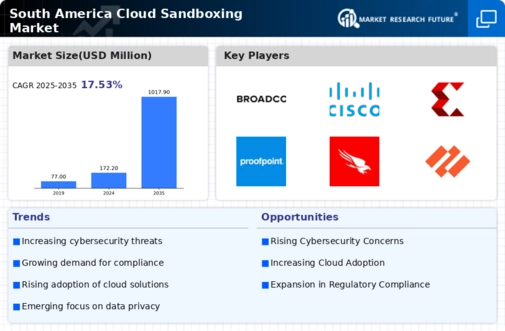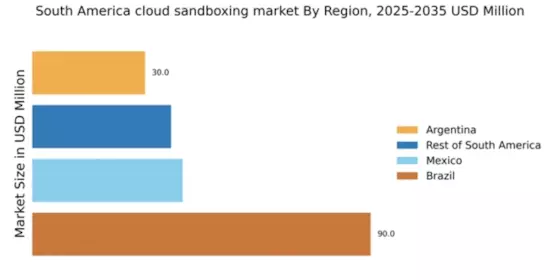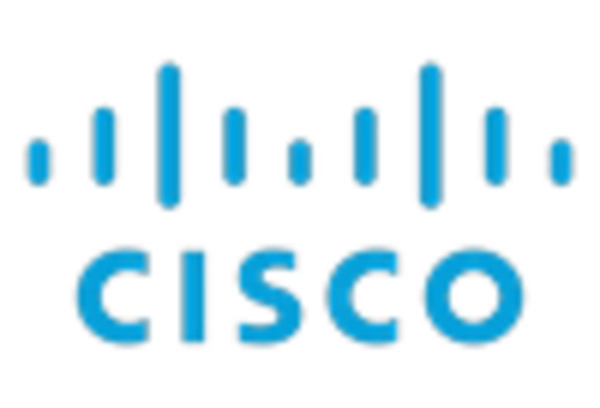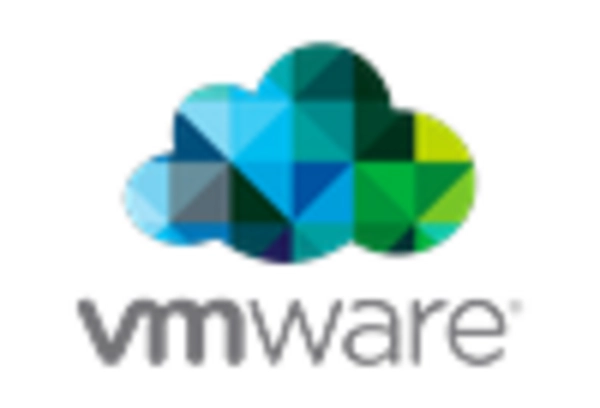Increasing Cyber Threats
The escalating frequency and sophistication of cyber threats in South America is a primary driver for the cloud sandboxing market. Organizations are increasingly recognizing the necessity of proactive measures to safeguard their digital assets. In 2025, it is estimated that cybercrime costs in the region could reach $150 billion, prompting businesses to invest in advanced security solutions. Cloud sandboxing provides a controlled environment for testing and analyzing potential threats, thereby enhancing overall security posture. As companies face the challenge of protecting sensitive data, the demand for cloud sandboxing solutions is likely to surge, reflecting a broader trend towards comprehensive cybersecurity strategies in the region.
Growing Demand for Innovation
The increasing demand for innovation in product development and software testing is a significant driver for the cloud sandboxing market. In South America, businesses are under pressure to accelerate their development cycles while ensuring security and compliance. Cloud sandboxing provides a flexible environment for developers to experiment with new ideas without risking the integrity of production systems. This approach not only fosters innovation but also reduces time-to-market for new products. As organizations prioritize agility and innovation, the adoption of cloud sandboxing solutions is expected to rise, reflecting a shift towards more dynamic development practices.
Adoption of Cloud Technologies
The rapid adoption of cloud technologies across various sectors in South America is significantly influencing the cloud sandboxing market. As organizations migrate to cloud-based infrastructures, the need for robust security measures becomes paramount. According to recent data, the cloud services market in South America is projected to grow at a CAGR of 20% from 2025 to 2030. This growth is driving the demand for cloud sandboxing solutions, which allow businesses to test applications and software in a secure environment before deployment. Consequently, the integration of cloud sandboxing into cloud strategies is becoming increasingly essential for organizations aiming to mitigate risks associated with cloud adoption.
Regulatory Landscape Evolution
The evolving regulatory landscape in South America is compelling organizations to adopt cloud sandboxing solutions. Governments are implementing stricter data protection regulations, which necessitate compliance measures that can be effectively managed through sandboxing. For instance, the introduction of data privacy laws is expected to increase compliance costs by up to 30% for businesses. Cloud sandboxing enables organizations to simulate compliance scenarios and assess their readiness for regulatory audits. As companies strive to meet these regulatory demands, the cloud sandboxing market is likely to experience growth, driven by the need for effective compliance strategies.
Investment in IT Security Infrastructure
The rising investment in IT security infrastructure across South America is a crucial factor propelling the cloud sandboxing market. Organizations are increasingly allocating budgets to enhance their cybersecurity frameworks, with an estimated 15% increase in IT security spending anticipated in 2025. This trend is driven by the recognition that traditional security measures are insufficient to combat modern threats. Cloud sandboxing offers a proactive approach to security, allowing organizations to identify vulnerabilities and test defenses in a controlled setting. As businesses continue to prioritize security investments, the demand for cloud sandboxing solutions is likely to grow, reflecting a broader commitment to safeguarding digital assets.


















Leave a Comment